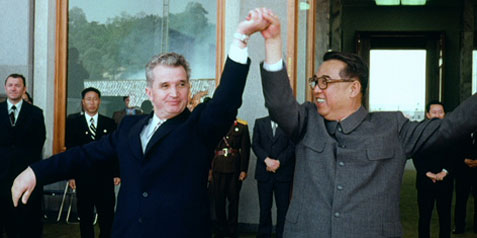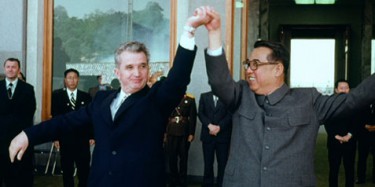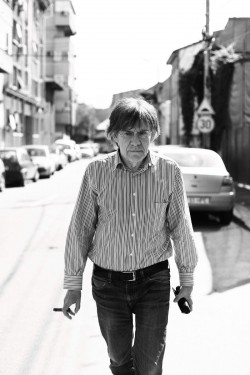 Back to selection
Back to selection
ANDREI UJICA, “THE AUTOBIOGRAPHY OF NICOLAE CEAUSESCU”


Romanian émigré and film essayist Andrei Ujica’s acclaimed Videograms of a Revolution trilogy, which includes the 1992 film of that name as well as his profile of cosmonaut Sergei Krikalev, Out of the Present (1995), finally concludes with The Autobiography of Nicolae Ceausescu, his genre-bending final chapter, which he fondly calls part of the “new non-fiction” that is taking the world of cinema by storm. Culling through several decades worth of propaganda films from the Romanian National Television and Film Archives, he takes wildly out of context footage and gently stews it together into a three hour epic rumination on Romania’s mid and late Communist periods as told from the decidedly rosy verging on megalomaniacal perspective of the brutal 20th century dictator himself whose filmic autobiography we’re ostensibly watching. Unlike anything else that will find its way to commercial screens the year, the movie is a dazzling historical tour-de-force that shows both the hypocrisy of western liberal democratic and Communist bloc countries in their embrace of the self-deluding dictator.
While he trotted around the globe, hobnobbing with the likes of Kim Jong-Il, Richard Nixon, Charles De Gaulle and finally Jimmy Carter, Ceausescu’s Romania was perhaps the most brutal regime behind the Soviet curtain, with its systemic repression, failed attempts at industrialization and an authoritarian police state like few others. While little of that appears explicitly in Autobiography, Ujica shows Ceausescu’s public persona as little more than an unstable and deliberate fabrication. The Autobiography of Nicolae Ceausescu had its world premiere at Cannes 2010 before playing at last fall’s New York Film Festival. It opens at the Elinor Bunin Munroe Film Center in Manhattan on Friday via The Film Desk.

Filmmaker: You recount Ceausescu’s rise to power and brutal reign seemingly from his own chilling, romanticized point of view using previously unused state propaganda footage and home movies. Why did you choose the way into his and Romania’s story?
Ujica: There are some reasons for that, philosophical ones, aesthetic ones and some related to cinema itself. If we begin with a philosophical observation, and I’m quite sure I’m not the only one who thinks this, immediately after a major historical event happens, in our case the change of epoch in 1989, the proper way of approaching it is not a historiographical, meaning scientific, one. During such times, artistic means are more adequate in order to create „simulation models“ of the historical complexity, which happens because they incorporate the psychological component of reality. This makes narrative media, the ones that can recreate the theater of history, may them be the Novel or the Cinema, able to articulate an implicit analytical discourse of psychology of history. The greatest author in regards to the psychology of history was and remains Shakespeare. Later, towards the end of the 18th century and into the 19th century, the representation of history became more novelistic, so that history was told in chapters which included theatrical scenes. By the end of that century, you had a massive work, in the sense of a model of aesthetic simulation of history, like Tolstoy’s War and Peace.
All of this is to say that, after the change of age in ’89, we had a major philosophical crisis because the entire utopian constructions that came from the Enlightenment suddenly imploded. The academic theoretical discourse has been confronted with this crisis (one of the most significant in the history of philosophy) ever since, its main preoccupation being the sorting of books inside libraries, where entire shelves full of “reference works” have turned overnight into “waste paper”.
Here is another reason to try to understand the events which occurred twenty years ago and what caused them through aesthetic means. If you are working in a narrative medium like the cinema, then you are probably attracted by the psychological complexity of reality, for that is what narrative cinema is and can do. As far as I am concerned, my major interest has always been directed towards a cinema of reality, which tries to reformulate the equation between document and emotion. And, to my great joy, I discover that I was not the only one preoccupied by this lately. I am convinced that it will be one of the major developments in the decade that has just begun. The emergence of new possibilities in the cinematic discourse on the border of fiction and non-fiction is the most interesting area of development in cinema at the moment.
Filmmaker: I agree.
Ujica: That’s why, from this perspective, one way to try to understand the events of two decades ago is to adopt some of the means of the historical novel, to construct a psychological system around historical figures. I thought it would be much more interesting not to use the means of the classical fiction cinema, to write a script, choose an actor and, this way, to make a movie which passes as the biography of Ceausescu. For me it was much more interesting the proposition to create a kind of historical epic that is made from documents but at the same time is not a documentary in the normal accepted sense. I’m saying this because the documents mentioned are not used as arguments in a demonstration, but rather as preserved fragments of life, which are waiting to be reintegrated in the historical sequence. We don’t yet have a proper terminology for these things which are now happening in the new non-fiction cinema. But no matter what their name will end up to be, the last two years have definitely produced the most interesting results in all of cinema.
Filmmaker: The footage you used was shot for official purposes and perhaps in some state of limbo after the regimes fall. I imagine finding this footage involved extensive archive support?
Ujica: From a logistical point of view, the organization of the research was easier than I expected and easier than for the other two films in this trilogy, which both dealt with a variety of sources. The Ceausescu images are centralized in two big archives, at the National Television and the National Film Archive, which is the archive of the former State documentary film studio, whose job was to chronicle Ceausescu’s activities. So all of these images can be found in only two places and a major part of what they had was identical, because the few cameramen who had the permission to shoot at “degree of protocol zero” were employed at the time by the documentary film studio. Starting with mid ’70s, this license was also granted to a small group of TV cameramen, who shot their own images. They all shot on film until very close to ’89. They only switched to video equipment a few months before the end. That’s why almost the entire material that I had at my disposal for this project was shot on film…
Filmmaker: You were an expat for awhile, but you were a child when Ceausescu came to power and came of age during this awful era for your country, as his regime slipped into perversity, absurdity and terror. When in your own development did you decide you had to make some sort of aesthetic statement about these events and how did that desire lead to the Videograms of a Revolution trilogy? I’m sure you couldn’t have foreseen back them having such an embarrassment of riches in terms of material with which to work with.
Ujica: The idea of a trilogy was developed backwards. When I made Videograms, together with Harun, in 1992, I didn’t know I would make three films to close this subject. At the time I was working at the first two movies, the events were still very hot and we were all terribly excited, all the guys in my generation, who shared a similar experience of totalitarianism and immigration from an Eastern country. We were all driven by a huge curiosity to try to understand more about what had happened. Probably because we weren’t there at the moment, we saw these events on television from Western countries, for me it was from the American zone in West Germany. Out of the Present was finished in the summer of 1995. Ten years later, in 2005, I was confronted with the idea of a project about Ceausescu for the first time. I was in Bucharest when Romanian television broadcast Videograms with a delay of 13 years and I was invited to discuss the movie from the studio. I ran into an old producer friend of mine, Velvet Moraru, who asked me if I didn’t feel like the time had come for an ’objective’ biography of Ceausescu. I thought the time was right.
I got back to Germany and I thought a lot about whether such a movie was truly necessary. I had several things in mind. I thought that I would be able to finally close my preoccupation for the subject and to make a trilogy. I was also very curious to know a little bit more about who was this man behind the historical cliché who influenced our lives so much. From that point onwards, it was quite easy to find the perspective. It was clear that I needed to work in a similar stylistic register as in the previous films, but to work in a more radical way with existing historical visual documents. Therefore, the autobiographical perspective was quite simple to find because you have no alternative, each archive of a chief of state, is a protocol archive. It doesn’t matter if we’re dealing with a dictator or with a democratically elected chief of state, it’s a protocol archive, it’s made by his own propaganda or media apparatus. It was clear to me that the only way to use authentic footage in this film, was to make it from the autobiographical point of view.
Filmmaker: How did you go about organizing what I assume was a massive amount of footage to use.
Ujica: In my estimation, there are about 1,000 hours of archival footage of Ceausescu. The researchers made a pre-selection for me. I gave them a number of very simple criteria, to cover all the major dates in his political biography and to choose all of the ’authentic’ moments from the (beginning and the end of) shooting, when something is passing outside of the protocol. The pre-selection was around 260 hours. So I began my selection of the material with these 260 hours together with Dana Bunescu, this very gifted editor and sound designer. We took a lot of time organizing the material, we actually worked for almost one year with a few interruptions, it was about ten months of work time. We organized a chronological archive, another one on subjects, Ceausescu in different situations and so on. When we started the editing, we knew the material so well, that we were able to make a final cut in the course of about five months. At the end of that process, the film was only sixteen minutes longer than the film you see today. We didn’t cut any entire scenes out, only segments of certain scenes that still exist in the film. It’s a very fascinating process to work like this, in this kind of syntactic cinema, the images, the morphology, they already exist. This preexisting morphological material gives you the possibility to build new phrases and with these phrases build a new narration. The first thing you do is to deconstruct the previous editing. The biggest part of the materials were rushes, rough materials, but in some cases you had some propaganda editing that had already taken place and the first thing you must do is deconstruct this material and put it in its original form and work without the voice narration from the propaganda material. You make a semantic interpretation of these “morphemes” in the form of fragments of reality preserved as moving images and then you build scenes and your own narration around it. It’s an intimate secret, this kind of work.
Filmmaker: Do you think that making this film was therapeutic for you at all?
Ujica: Yes, I once said that all three parts of the trilogy have been a sort of historical therapy for me. I don’t know, at the same time, each novel or each film is a therapy for the personal biography of their author, but this particular one, from the point of view of our second biography, namely the historical one, is pretty significant for me. I now feel completely free from this entire period in my life, free from an entire epoch, free from the political and ideological context of the Communist utopia. So in that way, I suppose the therapy was successful.
